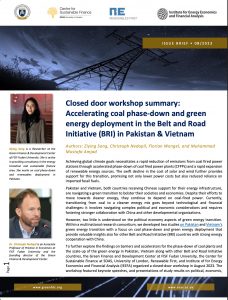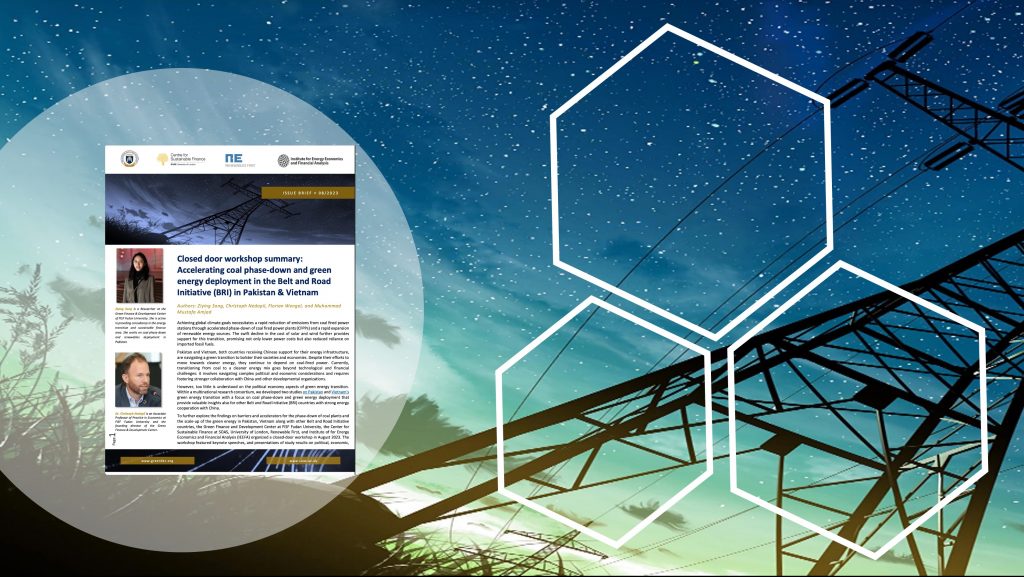
Achieving global climate goals necessitates a rapid reduction of emissions from coal fired power stations through accelerated phase-down of coal fired power plants (CFPPs) and a rapid expansion of renewable energy sources. The swift decline in the cost of solar and wind further provides support for this transition, promising not only lower power costs but also reduced reliance on imported fossil fuels.
Pakistan and Vietnam, both countries receiving Chinese support for their energy infrastructure, are navigating a green transition to bolster their societies and economies. Despite their efforts to move towards cleaner energy, they continue to depend on coal-fired power. Currently, transitioning from coal to a cleaner energy mix goes beyond technological and financial challenges: it involves navigating complex political and economic considerations and requires fostering stronger collaboration with China and other developmental organizations.
However, too little is understood on the political economy aspects of green energy transition. Within a multinational research consortium, we developed two studies on Pakistan and Vietnam’s green energy transition with a focus on coal phase-down and green energy deployment that provide valuable insights also for other Belt and Road Initiative (BRI) countries with strong energy cooperation with China.
To further explore the findings on barriers and accelerators for the phase-down of coal plants and the scale-up of the green energy in Pakistan, Vietnam along with other Belt and Road Initiative countries, the Green Finance and Development Center at FISF Fudan University, the Center for Sustainable Finance at SOAS, University of London, Renewable First, and the Institute of for Energy Economics and Financial Analysis (IEEFA) organized a closed-door workshop in August 2023.
The workshop featured keynote speeches, and presentations of study results on political, economic, technological, and social drivers and barriers in Pakistan and Vietnam that impact the energy transition. The workshop also included panel discussions that delved deeper into the topic of how to support an accelerated coal transition given the interplay of host countries, Chinese investors, as well as multilateral development banks (MDBs), and how to make the next steps possible.
During the workshop, experts from the local government, financial sector, development finance institutions, academia and think tanks from 16 organizations participated and shared progress, obstacles, and opportunities for the green energy transition including for BRI countries. The workshop was supported by the World Resource Institute.
Key takeaways:
- It is crucial to fully comprehend political barriers by decision-makers including political risks in both the host country and in China in addition to integrating economic and social considerations to accelerate a green energy transition. This includes aspects of entrenched interests, but also lack of knowledge on developments of rapidly decreasing renewables pricing, local policies, financing options, and economic opportunities through renewable energies.
- The phase-down/out of coal plants must happen in tandem with scaling of renewable energy and grid development. The insufficient grid system that causes severe curtailment and inadequate evacuation remains a significant challenge for incremental renewable investment in Pakistan and Vietnam in the short term.
- The green energy transition including phase-down of coal plants can be achieved with positive returns for current investors, if proper financing mechanisms are applied to accelerated phasing down of coal fired power plants (CFPPs), such as green refinancing, managed transition vehicles.
- Recent initiatives such as the Energy Transition Mechanism (ETM) and Just Energy Transition Partnership (JETP) provide knowledge and highlight innovative financing schemes, i.e., refinancing, bundled investment, debt-to-climate/coal-to-renewable swaps, which could provide opportunities for pilot projects or prototype retirement that can be adapted to different country contexts.
- Multilateral Development Banks are diversifying their funding package beyond loans to actively support the green transition to include policy-based loans, locally issued bonds to support energy transition; more local currency offerings as well as guarantees have been explored to counter ongoing debt crises in many countries.
- Taking action for accelerated green energy transition needs to overcome numerous challenges, e.g., financing constraints, lack of planning capacity, lack of energy markets, and overall political planning processes. Thus, despite progress and willingness to engage in accelerated green energy transition, BRI countries need differentiated energy transition financing and pathways depending on their access to finance, local capabilities in planning, energy market developments, entrenched interests, and overall electricity development strategies.
The following briefing summarizes the workshop discussions and outcomes.
Key barriers identified for coal transition and renewable deployment
From the keynote speeches and presentations, it became apparent that Pakistan and Vietnam share some similarities in their energy transition challenges, which can offer valuable insights for other Belt and Road Initiative (BRI) countries. Both nations have received significant support from China, particularly in their coal power development. However, they both encounter barriers such as financial constraints, regulatory challenges, and the need for technological advancements as they strive to transition toward cleaner energy sources. Understanding the experiences of Pakistan and Vietnam can illuminate the path for other BRI countries facing similar energy transition hurdles.
In both Vietnam and Pakistan, vested interests play a significant role in supporting the coal industry. Business owners, foreign investors (i.e., Chinese state-owned enterprises (SOEs)), and some political actors benefit from the current reliance on coal as coal industry (i.e., coal mining, coal transportation, coal power generation) usually at the hands of local government or SOEs, particularly in regions with a strong coal presence (i.e., Sindh province in Pakistan). These “invested groups” that revolve around fossil fuels believe that sustaining coal usage contributes to regional employment and prosperity, long-term income, or financial viability.
Both countries have various types of direct and indirect coal/fossil fuel subsidies that e.g., reduce fuel costs for local coal-based power generations and lead to distortion of electricity tariffs. Vietnam regulates electricity price to be low to maintain its industrial sector’s competitiveness in exports. These subsidies potentially hinder the transition to a greener power mix.
Integrating large-scale renewable energy (RE) into the grid and ensuring reliability while transitioning away from fossil fuels are common challenges for both countries, with coal playing a big part in their baseload (Pakistan: 14% of capacity mix as of June 2022; Vietnam: around 30% of its capacity mix as of 2021) and renewables remain non-dispatchable without proper energy storage.
RE expansion in Pakistan and Vietnam is greatly constrained by weak transmission network that cannot handle the intermittent nature of renewable sources. Pakistan, for example, had to curtail renewables due to underdeveloped grid systems, although the overall solar and wind installation constitutes currently only 6% of the capacity mix. In Vietnam, the rapid increase in solar and wind-generation capacity (about 28% of total installed capacity as of 2021) has overloaded the electricity grid in several provinces and resulted in a cut in RE output.
Investor confidence in renewable investment is often lacking, as is a mature local financial system to support an accelerated green energy transition. Due to transmission constraints, RE curtailment has led to curtailment loss of generation, which could deter incremental RE generation investments and “curtail” transition in the short term. For Vietnam, SOE-dominated power generation sector impedes investor’s ability and interest to engage in RE projects. In Pakistan, while its generation side is dominated by independent power producers (IPPs) – the inability of Central Power Purchasing Agency (owned by state) to pay RE IPPs and government-initiated renegotiation of contracts further discourages new investment. At the same time, the financial system of these two countries is characterized by limited means to raise capital domestically but rather a reliance on foreign/international finance in energy infrastructure.
The relatively “young” nature and long-term contract periods for coal projects in both countries indicate long debt payback obligations and large uncollected revenues. A large portion of finance (debt or equity, or both) from Chinese SOEs or/and state-owned financial institutions has made the renegotiation of existing coal projects extremely difficult. This is especially true in Pakistan, where every China-backed coal IPPs are guardrailed by sovereign guarantees, accompanied by generous financial packages, i.e., return on equity (ROE) could range from 27-35% . Therefore, early phase-down of these coal plants would require a favourable design of financial mechanisms that trade-off among the debt unpaid, the reduced earnings, and the left equity through restructured contracts.
The acceleration of green energy transition is not a one-size-fits all model, as already evident in the cases of Pakistan and Vietnam, given their economic status and policy priorities. This can provide lessons for other BRI countries.
- Pakistan has seen shifts in political directions, competing interests among various political factions, potential policy inconsistencies, significant intervention of the state of the power sector, an ongoing debt crisis (i.e., circular debt), and RE installations that still rely on imports. BRI countries that have similar political economies could include Siri Lanka, Bangladesh, Nepal, etc.
- Vietnam has a more stable political situation and a positive economic outlook. Its RE deployment is more rapid and Vietnam has policies in place for coal transition with active participation in international climate treaties and cooperations that possibly open doors for more investment. Similar countries to Vietnam in BRI could be Indonesia, Philippines, etc.
Key enablers that could be levered for coal transition and renewable deployment
The shift in global and local financial resources has accelerated divestment from coal in both Pakistan and Vietnam. In Pakistan, obtaining funding for non-committed coal projects has become challenging as primary lenders, including Chinese entities, are aligning with China’s 2021’s commitment to shift away from coal in outbound investments. In addition, major local banks like Habib Bank Limited (HBL) have implemented a “no new coal” policy, further restricting financing options. Similarly, in Vietnam, difficulties in mobilizing investment capital for coal expansion arise from an increasing number of domestic and international financial institutions refusing to finance coal-fired power plants due to climate-related risks. Vietnam’s latest long-range power development plan (PDP8) released in May 2023 puts a stop to new coal-fired power plants after 2030 and cancels around 13GW of planned coal capacity from the pipeline while keeping 13 GW committed coal projects – yet half of them face financial arrangement issues.
Collective efforts and initiatives from public and private sectors at the global and regional levels on coal transition have gained momentum. Multiple BRI countries (e.g., Pakistan, Bangladesh) have announced to phase-out new coal investments. In 2021, the world’s largest public funders of coal power (China, South Korea, Japan, and the G7) committed in the lead-up to COP26 to cease international public finance for new coal projects. Enabling platforms such as Energy Transition Mechanism (ETM) which has been conducting a pre-feasibility study in Pakistan to explore coal and other fossil fuel early retirement opportunities, the Just Energy Transition Partnership (JETP) that reached a deal with Vietnam, etc. have become pivotal forces to facilitate coal transition in these developing countries. These advancements leverage financial support and provide an impetus for broader action for reducing coal-fired power and accelerating the transition to renewable energy within the BRI and beyond.
China, Pakistan, and Vietnam’s major investor in the energy sector and coal assets, is promising to build a “green Belt and Road Initiative”. China’s “no new coal overseas” pledge in 2021, prioritizing renewable energy investments, aligning with global green finance standards, and releasing of several policies to green BRI engagements have revealed its future strategy. According to GFDC’s latest report on BRI series, China’s energy related engagement in the first half of 2023 were the greenest in any 6-month period since the BRI’s inception in 2013. The report also envisages further rebound of China-BRI country partnerships in renewable energy and related technologies for the rest of 2023.
Pakistan and Vietnam have evolving preferential policies that foster greater uptake of renewable energy sources. In Pakistan, the “Solar Fast Track Program 2022” aims to add 10 GW of solar energy rapidly to the grid, offering priority payment mechanisms (out of the default situation in IPPs payment) and a sovereign guarantee to provide reassurance to investors. In Vietnam, the recent development in renewable policy mechanisms, such as the direct Power Purchase Agreements (PPAs) that address the challenge of grid overload, would contribute to maintaining the momentum in the country’s energy transition.
Pathways for accelerating BRI countries’ transition from coal-fired power generation
Tripartite cooperation among host countries, China and MDBs, and potentially international partners is essential to expedite the shift to green energy in the Belt and Road Initiative (BRI) region. This concerted effort is regarded as a pivotal policy priority for BRI nations in their pursuit of establishing a green energy system and fostering a resilient regional partnership.
What are innovative financing mechanisms to support the coal-to-RE transition in the BRI and beyond?
Refinancing (with a slightly lower interest rate); and bundled investment (redirecting refinanced cash flows to RE capacity) can trigger opportunities to program early retirement or RE expansion for China-funded coal-fired power plants in Pakistan and Vietnam. A recent value-based analysis highlighted that these two transitioning finance measures can generate positive net present value (NPV) compared to letting CFPPs complete their PPAs terms in a business-as-usual scenario.
Chinese SOEs and state-owned financial institutions that backed BRI coal assets should reduce stranding risks by accelerating the use of these innovative financing mechanisms and improving collaboration with international developers and financing schemes to facilitate plans shifting to RE in BRI. Also, for countries with sovereign debt issues, such as Pakistan, a debt-for-climate or coal-to-renewable swap that partially/fully relinquish future payments owed to Chinese SOEs in exchange for green transition through early retirement or RE repurposing of the coal-fired power plants.
What are MDBs doing to support countries like Pakistan and Vietnam in low carbon transition and to address issues for countries with ongoing debt crises and currency volatility?
Multilateral Development Banks (MDBs) are taking proactive actions to support the energy transition in Asia and beyond.
- First, most MDBs have categorized coal projects as non-aligned to Paris Agreement goals and are examining future gas and fossil fuel projects’ feasibility with more scrutiny, considering factors beyond financial viability. These assessments encompass technology efficiency, carbon emission cost, stranded asset risk, decarbonization trajectory, and the potential for integrating Carbon Capture and Storage (CCS) technology, etc.
- Secondly, varying financing approaches have been implemented for different markets. In countries like India and Vietnam, where significant progress in renewable energy development is evident, MDBs prioritize mobilizing private investment through capital market initiatives and innovative financing to expand the market, rather than direct project financing. On the other hand, for nations facing policy challenges, such as Pakistan, Kazakhstan, Sri Lanka, and others, MDBs are more inclined to offer project-level support. They work collaboratively with governments to de-risk energy transition initiatives, instill investor confidence by sharing risks, and lower the cost of capital, thereby facilitating the transition to cleaner energy sources.
- Thirdly, various MDBs are adopting more diverse funding approaches, moving beyond concessional loans to encompass policy-based loans (offering budgetary support for government programs or energy sector reforms) and guarantees, with a potential shift from debt-based approaches to equity-based ones. Grants are considered only when specific indicators are met for energy projects. Moreover, the MDBs are actively issuing bonds in local markets and engaging in currency swaps to expand local currency offerings. This approach helps reduce the burden on countries facing ongoing debt crises, enhancing their financial flexibility and strengthening their energy transition endeavors.
How could the rapid evolution of new energy technologies facilitate green energy transition in BRI?
To phase down coal, it is important to provide an equally stable and consistent supply of electricity. This requires enhancing the electricity grid and fostering storage solutions along with the adoption of alternative renewables. The prices for energy storage are also falling rapidly, which means that grid tied “RE + storage” will be increasingly competitive with coal generation and thereby a critical enabler for green energy transition in BRI countries. Meanwhile, distributed generation and smart grids can play an essential role to bypass baseload constraints. Particularly for countries with weaker distribution and transmission network like Pakistan. China is a leader in RE technologies and energy storage development and could provide valuable lessons learned in policy design and conquer RE curtailment, etc. through capacity building, and establishing inter-organizational working groups. China could also provide technical assistance and offer specialized training to facilitate the establishment of RE supply chains in host countries while also expanding its scope of overseas green industries.
Power generation flexibility can mitigate curtailment and the amount of energy storage for integrating renewable energy. For instance, in the process of phasing down/out coal power, a flexible approach that gradually reduces the operation hours of coal plants can be coordinated with the operations of RE and enable a smoother and faster transition. China is also exploring a more dynamic power system where coal power can take on a more flexible role instead of solely serving as baseload generation.
Except for continued technological advancement, discussions on the transition towards a greener energy system in BRI countries also highlighted the need to
- create clear signals for domestic and international investors through long-term transition plans and enabling regulatory frameworks;
- address the limited fiscal space and the limited ability to afford the public expenditure needed to catalyze private investment in coal retirement and alternative energies, and
- strengthen dialogues between social activists, local community representatives, and local governments to achieve an accelerated and equitable transition.
Conclusion
Navigating the coal transition and RE deployment in the BRI requires diplomatic negotiations, resource mobilization, balancing stakeholder interests, and a systemic shift involving policymakers, investors, technology providers, and civil society. It involves scaling up finance for green energy generation and distribution, finding just and politically viable solutions to phase-down coal dependence, and accelerating energy market reform.
Amidst encouraging progress in the discussions on coal transition and renewable energy expansion, China remains a crucial player. For accelerated green energy transition, China and BRI countries must collaborate across financial, social, and political-economic aspects, while also strengthening partnerships with Multilateral Development Banks (MDBs) that offer concessional finance.
Acting on accelerated green energy transition is challenging and requires specific research and plans with more tailored political-economy strategy for coal phase down that fits the specific context, specific engagement strategies with key stakeholders, and applicable forms of international support that can help facilitate accelerated coal phase‐down/out and renewable scale-up.











Comments are closed.